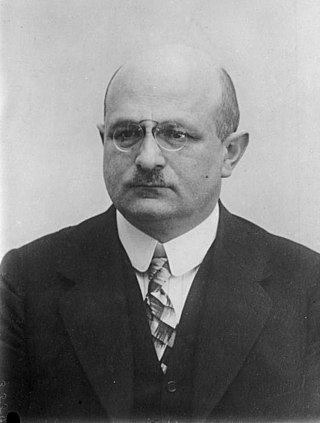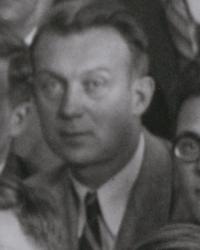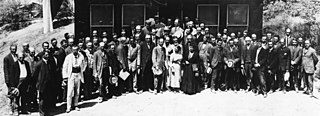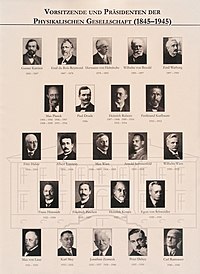
Arnold Johannes Wilhelm Sommerfeld, was a German theoretical physicist who pioneered developments in atomic and quantum physics, and also educated and mentored many students for the new era of theoretical physics. He served as doctoral supervisor and postdoc supervisor to seven Nobel Prize winners and supervised at least 30 other famous physicists and chemists. Only J. J. Thomson's record of mentorship offers a comparable list of high-achieving students.

Walther Wilhelm Georg Bothe was a German nuclear physicist know for the development of coincidence methods to study particle physics.

Max Theodor Felix von Laue was a German physicist who received the Nobel Prize in Physics in 1914 for his discovery of the diffraction of X-rays by crystals.
Ernst J. L. Gehrcke was a German experimental physicist. He was director of the optical department at the Reich Physical and Technical Institute. Concurrently, he was a professor at the University of Berlin. He developed the Lummer–Gehrcke method in interferometry and the multiplex interferometric spectroscope for precision resolution of spectral-line structures. As an anti-relativist, he was a speaker at an event organized in 1920 by the Working Society of German Scientists. He sat on the board of trustees of the Potsdam Astrophysical Observatory. After World War II, he worked at Carl Zeiss Jena, and he helped to develop and become the director of the Institute for Physiological Optics at the University of Jena. In 1949, he began work at the German Office for Materials and Product Testing. In 1953, he became the director of the optical department of the German Office for Weights and Measures.

Rudolf Fleischmann was a German experimental nuclear physicist from Erlangen, Bavaria. He worked for Walther Bothe at the Physics Institute of the University of Heidelberg and then at the Institute for Physics of the Kaiser Wilhelm Institute for Medical Research. Through his association with Bothe, he became involved in the German nuclear energy project, also known as the Uranium Club; one of Fleischmann's areas of interest was isotope separation techniques. In 1941 he was appointed associate professor of experimental physics at the newly established Reichsuniversität Straßburg, in France. Late in 1944, he was arrested under the American Operation Alsos and sent to the United States. After he returned to Germany 1946, he became Director of the State Physical Institute at the University of Hamburg and developed it as a center of nuclear research. In 1953, he took a position at the University of Erlangen and achieved emeritus status in 1969. He was a signatory of the Göttingen Manifesto in 1957.

Carl Wilhelm Ramsauer was a German professor of physics and research physicist, famous for the discovery of the Ramsauer–Townsend effect. He pioneered the field of electron and proton collisions with gas molecules.
Richard Becker was a German theoretical physicist who made contributions in thermodynamics, statistical mechanics, superconductivity, and quantum electrodynamics.
Karl Mey was a prominent German industrial physicist who directed the research and development branch of Osram AG. His presidency of the Deutsche Physikalische Gesellschaft, starting the year Hitler became Chancellor of Germany, was crucial in that organization's ability to assert its independence from National Socialist policies.
Wolfgang Karl Ernst Finkelnburg was a German physicist who made contributions to spectroscopy, atomic physics, the structure of matter, and high-temperature arc discharges. His vice-presidency of the Deutsche Physikalische Gesellschaft 1941-1945, was influential in that organization’s ability to assert its independence from National Socialist policies.
Georg Jakob Christof Joos was a German experimental physicist. He wrote Lehrbuch der theoretischen Physik, first published in 1932 and one of the most influential theoretical physics textbooks of the 20th Century.
Ernst Carl Reinhold Brüche was a German physicist. From 1944 to 1972, he was the editor of the Physikalische Blätter, a publication of the Deutsche Physikalische Gesellschaft.
Physik Journal is the official journal of the Deutsche Physikalische Gesellschaft. Before 2002 it was named Physikalische Blätter.
Wolfgang Gentner was a German experimental nuclear physicist.

Hans Kopfermann was a German atomic and nuclear physicist. He devoted his entire career to spectroscopic investigations, and he did pioneering work in measuring nuclear spin. During World War II, he worked on the German nuclear energy project, also known as the Uranium Club.
Johannes Wilhelm Heinrich Juilfs, also known by the alias Mathias Jules, was a German theoretical and experimental physicist. He was a member of the Sturmabteilung (SA) and then, in 1933, of the Schutzstaffel (SS). Prior to World War II, he was one of three SS staff physicists who investigated the physicist Werner Heisenberg during the Heisenberg Affair, instigated, in part, by the ideological Deutsche Physik movement. During the war, he worked as a theoretical physics assistant at the Kaiser Wilhelm Institute for Physics. During the denazification process after World War II, he was banned from working as a civil servant in academia. For a few years, he worked as a school principal, and then he took a job as a physicist in the textile industry. With the help of Heisenberg and the Minister of Lower Saxony, he was able to become a full professor at the Leibniz University Hannover.

Heinrich Matthias Konen was a German physicist who specialized in spectroscopy. He was a founder and organizer of the Emergency Association of German Science, and he was a member of the "Senate" of the Kaiser Wilhelm Society, the Reich Physical and Technical Institute, and the Reich Chemical and Technical Institute. When he was forced out of academia in 1933 due to his opposition to National Socialism, he became an advisor in the industrial sector, especially the Troisdorf Works. After World War II, Konen became rector of University of Bonn and then headed the Culture Ministry of North Rhine-Westphalia.
Walter Friedrich Karl Weizel was a German theoretical physicist and politician. As a result of his opposition to National Socialism in Germany, he was forced into early retirement for a short duration in 1933. He was a full at the University of Bonn, from 1936 to 1969. After World War II, he helped to establish the Jülich Research Center, and he was a state representative of the Social Democratic Party of Germany.
Reinhold Mannkopff was a German experimental physicist who specialized in spectroscopy. In 1939, he was a member of the first Uranium Club, the German nuclear energy project. After World War II, he was the secretary of the Northwest German branch of the German Physical Society for over 20 years.

Karl Friedrich Franz Christian Scheel was a German physicist. He was a senior executive officer and head of Department IIIb at the Reich Physical and Technical Institute. Additionally, he served as editor of the journal Fortschritte der Physik, the semi-monthly bibliographic section of the journal Physikalische Berichte, the Verhandlungen of the German Physical Society, and the society’s journal Zeitschrift für Physik. From 1926 to 1935, he was editor of the Handbuch der Physik. An endowment by Scheel and his wife Melida funds the annual awarding of the Karl Scheel Prize by the Physical Society in Berlin.
Herbert Arthur Stuart was a German experimental physicist who made contributions in molecular physics research. During World War II, he was director of the experimental physics department at the Technische Hochschule Dresden. From 1955, he was the head of the high polymer physics laboratory at the University of Mainz.









